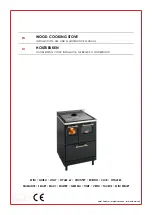
26
Vermont Castings • Intrepid II Installation & Operating Manual_R48 • 11/17
3-90-2000966
ST264a
add wood fire
11/00
Figure 41
- Add full size logs when the ember bed is 3" (75mm) deep.
Ash Disposal:
Remove ash before it reaches the top of the ash pan. Check
the level at least once a day, and before each re-fueling. If
the ash is close to the top edge of the pan, empty it according
to this procedure:
1. Open the damper.
2. Open the front doors fully.
3. Using stove gloves, pull the ash pan out of the stove by
its handle.
4. Remove the ash pan and properly dispose of the ashes.
Be sure to keep the pan level during disposal.
5. Return the ash pan to the stove.
Empty the ash pan regularly, typically every one to three
days. The frequency will vary depending on how you operate
your Intrepid II; if you burn more wood at higher heat output
settings, ash will accumulate rapidly.
Remove ash frequently and place it outdoors in a metal
container with a tight-fitting lid. Put the closed container of ash
on a noncombustible floor or on the ground, well away from
all combustible materials, pending final disposal. If the ash
is disposed of by burial in soil or otherwise locally dispersed,
keep it in the closed container until all cinders have thoroughly
cooled. You can use wood ash as a garden fertilizer.
Refuel While the Embers are Still Hot:
Reload the Intrepid II while it is still hot and there are plenty
of glowing embers to re-kindle the fire. Include some smaller
pieces of wood in the new load of fuel to help the stove rebuild
its operating temperature quickly.
Wear stove gloves, and follow this procedure when you
reload your stove:
1. Open the thermostat lever.
2. Open the damper.
3. Check the ash level in the ash pan; empty, if necessary,
and replace the pan.
4. Open the griddle.
5. Position the charcoal in the middle of the firebox (Figure
41) then load wood — smaller, split pieces first. Increase
the amount of fuel you load into the stove as you become
familiar with your stove and the heating needs of your
home.
NOTE:
If the remaining charcoal bed is relatively thick and
if your fuel is well seasoned, it is possible to add fresh fuel
(smaller pieces first), close the door and damper, and reset
the primary air thermostat for the desired heat output.
Do not break the charcoal into very small pieces or pound or
compress the charcoal bed.
It is important that air can circulate under the wood for the
fire to be quickly revived.
WARNING: Operate your Intrepid II only with the doors
either fully open or fully closed.
CAUTION: The Intrepid II will be hot while in operation.
Keep children, clothing and furniture away. Contact may
cause skin burns.
DO NOT OVERFIRE THIS HEATER.
Overfiring may cause
a house fire, or can result in permanent damage to the stove
and to the catalytic combustor. If any part of the Intrepid II
glows, you are overfiring.
Draft Management:
A stove is part of a system, which includes the chimney,
the operator, the fuel, and the home. The other parts of the
system will affect how well the stove works. When there is
a good match between all the parts, the system works well.
Wood stove operation depends on natural (unforced) draft.
Natural draft occurs when the smoke is hotter (and therefore
lighter) than the outdoor air at the top of the chimney. The
bigger the temperature difference, the stronger the draft. As
the smoke rises from the chimney it provides suction or ‘draw’
that pulls air into the stove for combustion. A slow, lazy fire
with the stove’s air inlet fully open indicates a weak draft. A
brisk fire, supported only by air entering the stove through
the normal inlet, indicates a good draft. The stove’s air inlet
is passive; it regulates how much air can enter the stove, but
it doesn’t move air into it.
Depending on the features of your installation - steel or
masonry chimney, inside or outside the house, matched to
the stove’s outlet or oversized - your system may warm up
quickly, or it may take a while to warm up and operate well.
With an ‘airtight’ stove, one which restricts the amount of air
getting into the firebox, the chimney must keep the smoke
warm all the way to the outdoors. Some chimneys do this
better than others. Here’s a list of features and their effects.
CAUTION
!
Never use your household or shop vacuum cleaner to
remove ash from the stove; always remove and dispose
of the ash properly.
















































